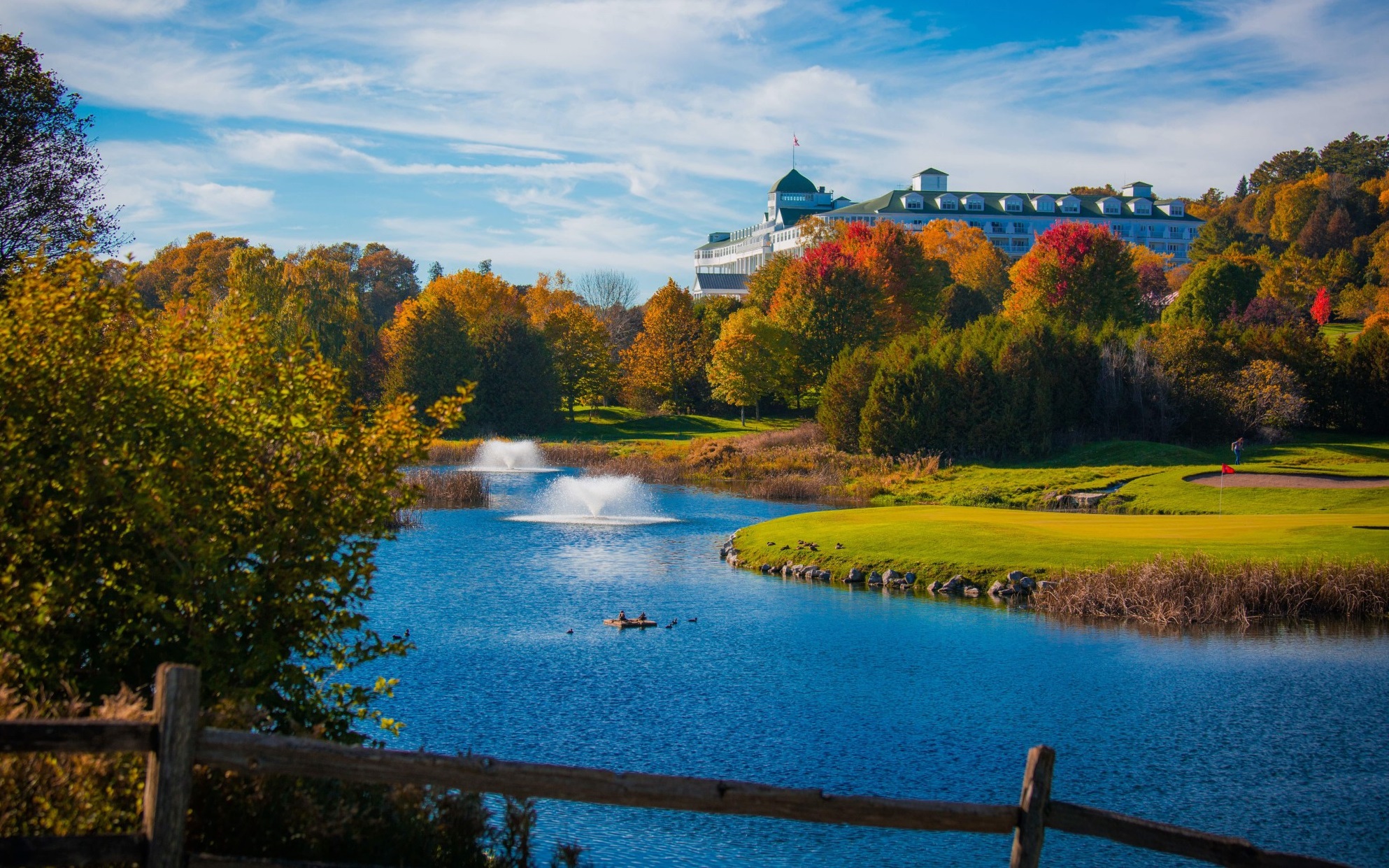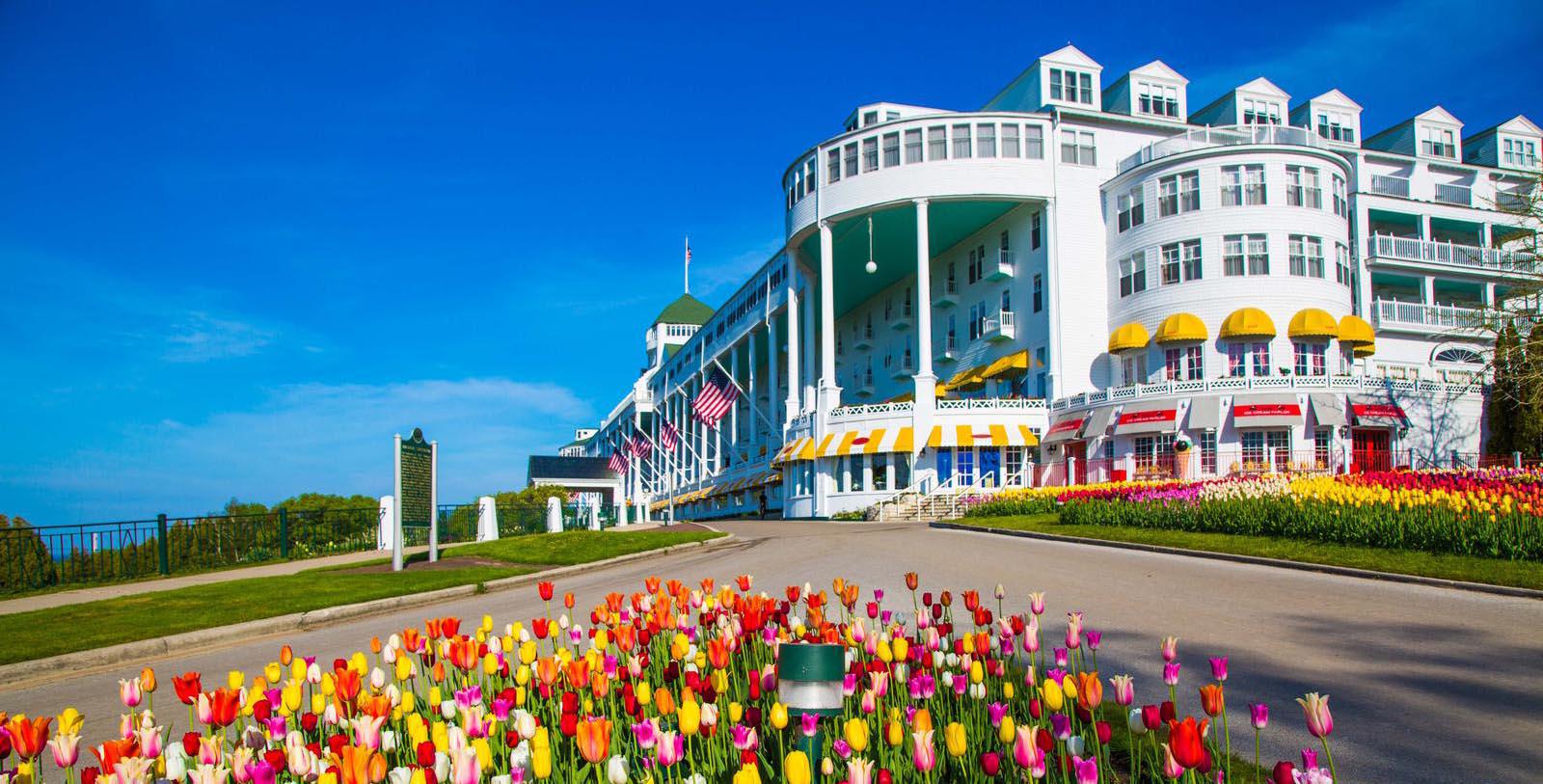Receive for Free - Discover & Explore eNewsletter monthly with advance notice of special offers, packages, and insider savings from 10% - 30% off Best Available Rates at selected hotels.
golf
Discover The Jewel Golf Course, which was once one of President Gerald Ford's favorite golf courses.
Grand Hotel on Mackinac Island provides its guests with a stunning 18-hole golf course known today as “The Jewel Golf Course.” The Jewel Golf Course itself is comprised of two nine-hole courses: the Grand Nine and the Woods Nine. Located across from the hotel with views of the Straits of Mackinac, the Grand Nine was designed by golf course architect Tom Bendelow in 1901. It quickly became immensely popular, leading the hotel to commission architect Jerry Matthews to renovate it several decades later. Then, in 1994, Matthews designed the Woods Nine, located in the interior of Mackinac Island with views of the Mackinac Bridge and the Upper Peninsula. Together, these two historic golf courses were melded together to form an even greater golf course known as “The Jewel Golf Course.” The Jewel Golf Course is now one of the most unique courses in Northern Michigan and the United States. As the only course in the country with horse-drawn carriage rides between nines, The Jewel Golf Course is truly a “Grand” golf experience. Among the many sports champions and notable figures who have played The Jewel Golf Course include Scott Simpson (winner of the 1987 U.S. Open Championship) and sports announcer Jim Nantz. President Gerald Ford himself was fond of Mackinac Island throughout his life, with his first visit taking place all the way back during his youth in the 1920s. (He specifically served as an Eagle Scout at the Mackinac Island State Park Commission’s Scout Service Camp.) President Ford thus returned frequently while on vacation, engaging in activities like sampling fresh candy at Mary’s Fudge, touring Fort Mackinac, and, of course, playing a round or two on the Grand Nine. Mackinac Island also offers golfers access to the nearby Wawashkamo Golf Club located in the island’s state park. There, guests can play one of the best-preserved links-style courses, designed and constructed by Scottish golf course designer Alex Smith in 1898. Born into one of Scotland’s most prominent golfing families, Smith spent most of his career as a club professional in the United States. He quickly grew in prominence due to his skill with a club, winning the U.S. Open in both 1906 and 1910 after his brother, Willie, had won it a decade earlier. Smith also gained prestige for his work on a couple American golf courses, including the brilliant holes that now define the historic Wawashkamo Golf Club.
-
About the Location +
Located within the Straits of Mackinac, Mackinac Island has been among the nation’s most celebrated holiday destinations since the late Victorian era. People from across the Midwest flocked to the island for its temperate weather and reclusive environment. In order to safeguard its rustic charm, many of the island's permanent residents passed legislation prohibiting vehicles onto the island. This ordnance is still in effect today, which helps to preserve Mackinac Island’s historical character. But before Mackinac Island became an internationally renowned vacation retreat, it once was home to traveling bands of the Anishinaabe. They specifically thought of the island to be scared, believing that the Great Spirit inhabited it following the end of a cataclysmic flood. Indeed, archeologists have since located all kinds of native artifacts along the coastline, including fishhooks, arrowheads, and other items. (Burial mounds for ancient chieftains have even been discovered around the area in recent years, too.) While records regarding the first European to arrive at Mackinac Island are scant, some historians speculate that it was Jean Nicolet during his journey to modern-day Wisconsin in the 17th century. Priest Claude Dablon then arrived several decades later to establish a short-lived mission on Mackinac Island. Jacques Marquette eventually replaced him in 1671, who decided to relocate the facility to St. Ignace. Nevertheless, a small fur trading outpost emerged on Mackinac Island, as the nearby Straits of Mackinac became an important nexus in French Canada.
Mackinac Island fell under British control during the late 18th century. Major Patrick Sinclair specifically landed during the American Revolutionary War and built a citadel called “Fort Mackinac.” Despite its imposing nature, Fort Mackinac was never attacked during the conflict. In fact, the British eventually surrendered the base to the nascent United States military at the end of the war! However, the British kept their desire to control Fort Mackinac and attempted to seize it outright at the start of the War of 1812. Indeed, the Royal Army managed to surprise the American garrison on-site amid a quick invasion of Mackinac Island. Looking to solidify their hold over the citadel, the British developed another base—Fort George—on the heights behind Fort Mackinac. American commanders yearned to take Mackinac Island and launched their own counteroffensive in 1814. The battle failed with the Americans’ second-in-command, Major Andrew Hunter Holmes, killed in the ensuring gunfight. Mackinac Island ultimately returned to the United States via the Treaty of Ghent, which concluded the war. In its wake, an influential population of Native American and French-speaking fur traders soon moved into the area, giving it a unique identity that was to last for decades. John Jacob Astor even located his American Fur Company on the island, which helped him amass an incredible fortune. The military presence was finally removed when Fort Mackinac closed permanently at the height of the Gilded Age.
Mackinac Island then started to become a popular tourist destination once the federal government made the area a national park during the 1870s. Word quickly spread of the island’s bucolic tranquility, inspiring many from across the Midwest to come and experience its charm. Soon enough, charters were ferrying guests out to Mackinac Island every year, making the site one of the most active places in the Great Lakes. A few transportation companies built a variety of hotels—including Grand Hotel—throughout the remainder of the 19th century, as well. But Mackinac Island was also gradually dotted with quaint seasonal cottages that wealthy industrialists had constructed to serve as their private retreats. As soon as the island reverted to the status of a state park in the 1890s, the newly empowered Mackinac Island State Park Commission took great pains to limit any future real estate developments. Thanks to the legislation, the commission’s actions have since guaranteed that Mackinac Island’s iconic serenity has remained largely untouched well into the present. The island has since preserved its status as one of America’s top vacation destinations, hosting thousands of people every year. Indeed, the island has hosted all kinds of illustrious guests, from Hollywood celebrities to sitting U.S. Presidents. Cultural heritage travelers have particularly enjoyed visiting the island regularly due to the many unique historical landmarks located in the vicinity. The attraction that those guests have found to be the most fascinating is the retired Fort Mackinac, which exists today as a museum open to public exploration.
-
About the Architect +
Tom Bendelow: A renowned golf course architect of some 600 courses, Tom Bendelow was born in Scotland during the late 1860s. He originally trained to become a typesetter during his youth, ultimately securing a job with the Aberdeen Free Press. But Bendelow had also developed an affinity for golf, which his father had originally taught him at a young age. Bendelow thus continued to practice the game whenever he was not working. He eventually brought his passion for golf over to the United States upon immigrating to northern New Jersey in 1892. Bendelow strictly treated the sport as a hobby though, as jobs in golf were incredibly rare at the time. But he had a chance encounter with oil tycoon Charles Pratt, which changed the trajectory of his life forever. Bendelow had begun giving private lessons to Pratt after the latter had advertised the position in a local newspaper. He subsequently decided to construct a small, six-hole practice course on Pratt’s estate to better instruct him. The experience proved fruitful as it attracted the attention of sporting goods manufacturer A.G. Spaulding. Impressed with Bendelow’s work, Spaulding hired him to exclusively construct golf courses across New York and New Jersey. Bendelow’s very first course as part of Spaulding’s team was the Van Cortlandt Golf Course, designed at the behest of the New York City Park District in 1899. From there, Bendelow created The Apawmis Club in Rye, New York. Harry Vardon—who had become Bendelow’s friend—declared the course to be one of the top three in the whole country when it finally debuted.
With Vardon’s ringing endorsement, a wealth of golf clubs quickly sought out Bendelow’s expertise. Among the new courses that Bendelow subsequently developed afterward included the 18-hole course at the East Lake Golf Club—the same exact place where Bobby Jones would later learn to play the game. But after working for Spaulding for years, Bendelow decided to take a new posting at Ashland Sporting Goods. He then moved around jobs for a bit until finally settling down as the Chief Golf Course Designer for the American Park Builders Company. His new responsibilities at the American Park Builders Company saw Bendelow create a variety of municipal plans for specialized golf communities. Nevertheless, Bendelow still managed to find time to construct state-of-the-art golf courses during his down time. His designs had become far more intricate and challenging, as epitomized by his work at the Medinah Country Club during the mid-1920s. When Bendelow died in 1936, he left behind a legacy as one of America’s most prolific golf course architects. Many hailed him as “The Johnny Appleseed of American Golf” and “The Dean of American Golf” due to his profound influence on the game in the United States. Most of his courses are still regarded today as masterpieces, including the work he achieved while developing the Grand Nine outside of Grand Hotel earlier in his career. Perhaps his most beloved course today is Medinah Course 3, which has hosted several major championships, including three U.S. Opens and two PGA Championships. Six of Bendelow’s surviving golf courses have even been listed on the U.S. National Register of Historic Places by the U.S. Secretary of the Interior.
-
Famous Historic Golfers +
Gerald Ford, 38th President of the United States (1974 – 1977)
































